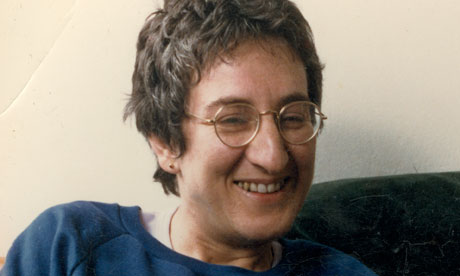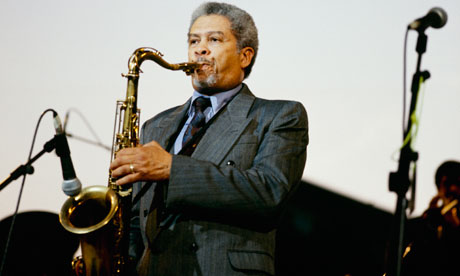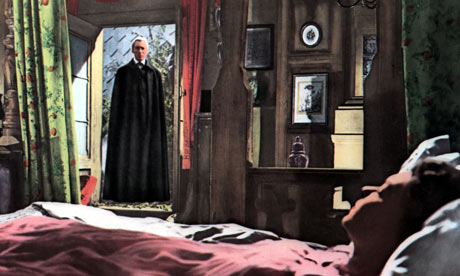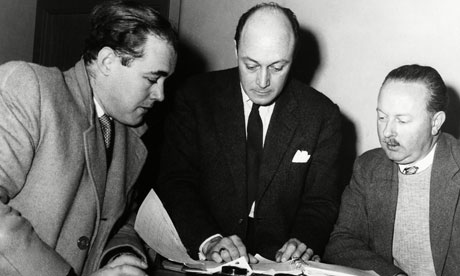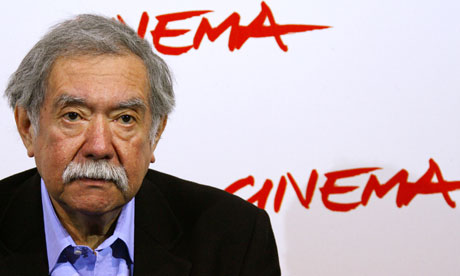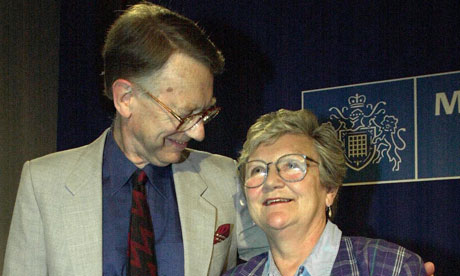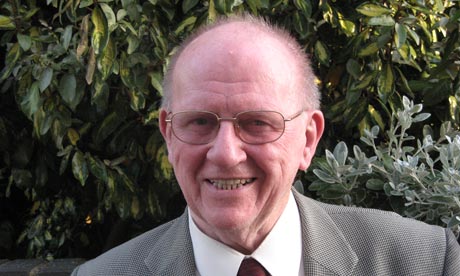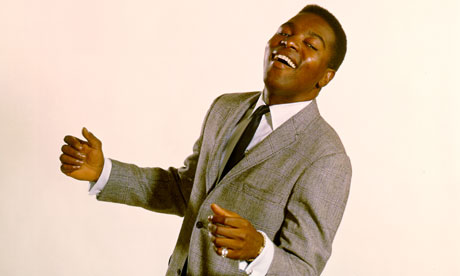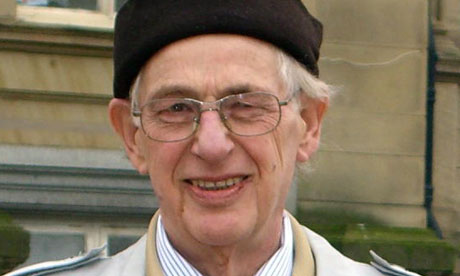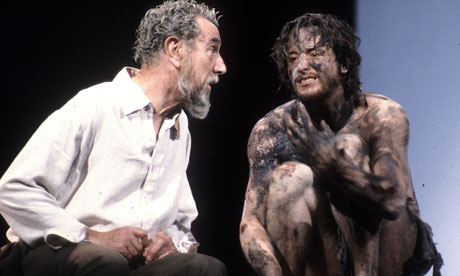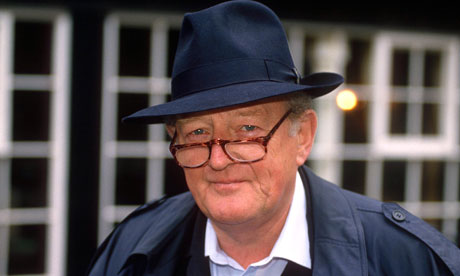
Robert Robinson, seen here in 1994, was fascinated by people's quirkiness.
The broadcaster and writer Robert Robinson, who has died at the age of 83 after a long period of ill health, had an extraordinary flair for either captivating or irritating his audience, or sometimes both. The wide range of programmes he presided over for BBC television included the film programme Picture Parade (1959), the arts review The Look of the Week (1966), and the quiz shows Call My Bluff and Ask the Family (or as he labelled them, "call my agent" and "ask your dad", both from 1967 onwards). In 1961 he started the five-minute slot for viewers' letters, Points of View, which has continued until the present under a dynasty of presenters, among them two further but unrelated Robinsons, Kenneth and Anne.
On Radio 4 from 1971 to 1974, he and John Timpson were the first to make the morning news programme Today a double-act, and endow it with that little trace of friction that has sometimes resurfaced since. For the next 18 years, until 1992, came the Saturday early-evening discussion programme Stop the Week, in which Robinson and friends mused – often at length – on matters arising tangentially from recent news stories.
On his own, except when calling for a ruling from the question setter, most of the time "Mycroft" (Ian Gillies, who died in 2002), he chaired the general-knowledge quiz Brain of Britain. From 1973 until interrupted by illness in his last seasons, standing down for good in 2010, he consoled and encouraged contestants with an idiosyncratic elegance of language scarcely to be found elsewhere on the airwaves – "Would that it were, Mrs Smith, would that it were"; "Come, Mr Jones, draw a bow at a venture..."
Including his early days as a writer and newspaperman, his career spanned more than half a century. Yet all the time he somehow gave the impression that he would prefer to be doing something of greater worth.
I had an early experience of this when we became friends in the mid-1950s. He was bemoaning his current job as film and theatre columnist of the Sunday Graphic, an admittedly rather pallid tabloid. Trying to cheer him up, I said that it wasn't a bad little paper. "Oh yes it is. That's exactly what it is – a bad little paper."
He was born in Liverpool, where his father was bookkeeper for a shipping company, though also a bookish character in another sense, learning languages and other skills to better himself. The family moved to London when Robert was a toddler, settling in the south London suburb of Mitcham. The local grammar school was Raynes Park, whose famed headmaster, John Garrett, lured the likes of Robert Graves, Harold Nicolson, Sybil Thorndike and C Day Lewis to address or perform for the boys, persuaded WH Auden to write the school song, and employed the inventive novelist Rex Warner as English teacher.
Garrett encouraged Robinson to aim for a county scholarship to his own Oxford college, Exeter, but it was to be a year before he could sit the exam and longer still before he could take it up. The flying bomb attacks on London in 1944 terrified his mother. He went back to Liverpool with her, and there worked as an office boy. On his return to Raynes Park (now under a new head) he won the scholarship, but first came national service, officer training, and two years in Nigeria commanding a service corps unit.
At Oxford he studied English, edited the student magazine Isis in 1950, met the actress Josee Richard, whom he would go on to marry, and imbibed the varsity lore and legend that underlies his first novel. How this actually came to be written some years later is another example of his wayward ambitions. Godfrey Smith, an Oxford friend and fellow journalist, happened to mention that his first novel had just been accepted. According to his own memoirs (Skip All That, 1996) Robinson was possessed by the news. It was as if Smith had climbed Everest. He dreamed that night, and every night, that he too had written a novel, and by day got on with it.
Landscape With Dead Dons (1956), a high comedy of a lost Chaucerian manuscript, plodding policemen and naked academics pelting through the streets of Oxford, was a deserved success. Over the years, two more novels, three miscellanies and the memoirs followed.
Meanwhile, his journalism was thriving. By 1960 Robinson was editing the prestigious Atticus column of the Sunday Times, and in 1965 took a turn as film critic of the Sunday Telegraph. That was also the year he hosted BBC3, the last manifestation of the Saturday-night television satire craze that had begun with That Was the Week That Was. He went on to conduct The Book Programme (1974-80), and buzzed around the world for Robinson's Travels (1977-79).
However, on television nothing gave him greater satisfaction than two eclectic single ventures. The first was a feat of literary detection he undertook with the director (and future BBC grandee) Will Wyatt. The true authorship of The Treasure of the Sierra Madre, a gold-panning story famously filmed by John Huston, had long been lost in a maze of false names and identities. Researching in Mexico, German and eastern Europe, they were finally able to call their 1978 report B Traven, a Mystery Solved: in 1983, Wyatt published their account as The Secret of the Sierra Madre.
From Robinson alone in 1986 came The Magic Rectangle, his investigation into the nature of television celebrity that I likened at the time to a medieval anatomist rooting around in corpses in an effort to locate the soul. As the title again implied, he concluded that the shape of the television screen bestowed the celebrity, but attracted only those who sought celebrity.
Was he himself of that inclination? Was he likewise the social climber that some held him to be? My guess is not, on both charges. When he and Josee married in 1958 and moved into a house in Chelsea next door to Richard Ingrams and his mother, it was not yet an especially fashionable area. They simply liked it - whether the pub was spilling out or the Queen was being entertained across the road - and stayed there all their life together. It became clear to me as a visitor how much spontaneous kindness and understanding Robinson was capable of when the situation called for it.
What he enjoyed most was people's quirkiness. When the concept of Eurovision was about to be launched in the late 1950s, we television hacks were taken on a brief tour of the national services taking part. As we shuttled from Calais to Brussels and Brussels to Antwerp we filed stories on the run or roughed them out for delivery as soon as we got back - except for Fred Cook, the down-to-earth correspondent from the long-lost Sunday paper of the cooperative movement, Reynolds News. He contentedly sampled the meals and the drinks without any visible attempt to secure an account of what we had seen. As the plane taking us home began its descent to Heathrow, he smoothed out a bit of paper and scribbled a few words. "There," he said, "that's broken the back of it." Robinson told this story for weeks, in admiration and wonder.
He is survived by Josee, their son Nicholas and daughters Lucy and Susie.
Dennis Barker writes: Robert Robinson would have liked to be Dr Samuel Johnson, the combative conversationalist and author who always argued eruditely and implacably, and always expected to win. Everyone who had dealings with him was wise to remember that. What he was really was a television-age compromise: possibly the last of the radio and TV presenters and quizmasters to have come from the literary and literate tradition rather than the glib, spuriously matey banalities of telly showbiz.
The telling point about his virtues was that he would never appear in commercials. He genuinely placed too much importance on the value of words as meaningful and disinterested tools of thought and wisdom to accept money for delivering even a sincere favourable opinion of sausages or toilet paper. He could be, and often was, called egotistical, self-centred, domineering and sneering, but at least one realised that the total effect was there because he intended it: he found it temperamentally impossible to be a creep.
It came as no surprise to anyone who knew him that his period as co-presenter of the Today programme was one of the shortest of his career. He was soon in trouble for attempting to say in his script about treatment of terrorist prisoners in Northern Ireland, that "torture" was a word now no longer in acceptable usage; it had been replaced by the officially approved phrase, "sensory deprivation". Told by the producer, who had seen the script in advance, that he could not broadcast that, he did not resign. He always felt that the fact he had not meant that he had connived at dishonesty.
One critic shrewdly observed that Robinson exemplified the meritocratic arrogance that had replaced the patrician version. Within those terms, he was certainly his own creation, though helped in his horizons by his headmaster's view that any schoolboy's opinions were "as good as the emperor's" – a liberating but dangerous message received loud and clear by Robinson, who set about being as "clever" as possible.
His first job in journalism was composing crosswords and fake readers' letters for The Weekly Telegraph. When a newspaper strike led to his appearing on a BBC television programme featuring otherwise-silenced print journalists, Robinson realised that he was a "natural", and was soon presenting Picture Parade. And when, on BBC3, Kenneth Tynan decided to create a TV first by using the word "fuck", Robinson was in no way disconcerted. He was much criticised in the subsequent set-to; but a man in a Lyons cafe in Holborn recognised him as having been on television, and the soon-to-be-ex-newspaperman liked that. He knew the limitations of what he did, but extracted top dollar for it from anyone who employed him – the series Robinson Country (1983-93), for example, was made for Television South West – and without the need of an agent.
In the 1990s, he presented the radio programme Ad Lib, in which he interviewed groups of people devoted to the same occupation. He was often able to abandon his combativeness in favour of rugged good nature, producing interesting material from people unused to talking publicly.
However, to him the pinnacle was Stop the Week. He always maintained that no formula had been found for reflecting the week's goings-on, and that every programme produced its own conversational rules, but in this he was deceiving himself: the sound of media folk creating an imaginary saloon bar with their often-used anecdotes about money, snobbery, gender, elitism and so on became an all too easily recognised formula. To some listeners, it became less a programme for lively minds than a refuge for the pretentious.
Robinson, the Johnson-manqué, liked to keep a tight hold on his Stop the Week court. After the recording of the programme he would often join the producer for the editing, in which some 10 or 15 minutes had to be cut. One regular founder-contributor who had noticed that some of his best quips were edited out, while Robinson's remained in, decided one week to join in this process. Whenever one of the contributor's bon mots approached on tape, the chairman found a technical reason why it should be edited out. "Come on, Bob," joshed the contributor. "You can't win them all." The contributor was myself.
"Oh yes, Dennis, I can, oh yes, I can!" was his instant and unapologetic response. And, through most media situations, he could. From now on, God may be having a rather harder time.
• Robert Henry Robinson, broadcaster and writer, born 17 December 1927; died 12 August 2011



